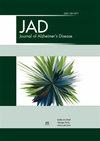体育锻炼与不可改变的阿尔茨海默病风险因素和脑健康标志物之间的关系:英国生物库研究
IF 3.4
3区 医学
Q2 NEUROSCIENCES
引用次数: 0
摘要
背景可调节(体育锻炼)和不可调节(性别和基因型)风险因素相互作用,影响阿尔茨海默病(AD)风险。该研究旨在评估体力活动、APOE 基因型和性别对阿尔茨海默病风险、脑容量和认知能力的影响。体力活动通过加速度计和国际体力活动问卷进行测量。研究结果包括AD发病率、脑容量(脑室脑脊液和大脑总量)和认知能力(执行功能、记忆力、视觉空间能力、处理速度和反应时间)。结果 69,060 名参与者符合纳入标准(平均年龄:62.28 岁,SD:7.84;54.64% 为女性)。较高的自我报告(OR = 0.63,95% CI [0.40,1.00],p = 0.047)和加速度计评估(OR = 0.96 [0.93,0.98],p = 0.002)体力活动与较低的疾病发病率相关。较小的脑室脑脊液容量(β= - 65.43 [- 109.68, - 17.40],p = 0.007)和较大的大脑总容量(β= 4398.46 [165.11, 8631.82],p < 0.001)分别与加速计评估的和自我报告的体力活动增加有关。两项脑容量分析均受性别影响。加速度计评估的体力活动水平增加与反应时间加快(β= - 0.43 [- 0.68, - 0.18],p = 0.001)有关;但视觉空间能力(β= - 0.06 [- 0.09, - 0.03],p < 0.001)和执行功能(β= 0.49[0.31,0.66],p <0.001;β= 0.27 [0.10,0.45],p =0.002)与自我报告的体育锻炼水平相关。性别对脑容量的调节作用凸显了将不可改变的风险因素纳入分析的重要性。本文章由计算机程序翻译,如有差异,请以英文原文为准。
The Relationship Between Physical Activity and Non-Modifiable Risk Factors on Alzheimer's Disease and Brain Health Markers: A UK Biobank Study.
Background
Modifiable (physical activity) and non-modifiable (sex and genotype) risk factors interact to affect Alzheimer's disease (AD) risk. Further investigation is necessary to understand if these factors influence brain volume and cognition.
Objective
The study aimed to assess the effect of physical activity, APOE genotype, and sex on AD risk, brain volume, and cognition.
Methods
UK Biobank data from 2006 to 2023 was accessed. Physical activity was measured by accelerometers, and International Physical Activity Questionnaire. Outcomes were AD incidence; brain volume (ventricular cerebrospinal fluid and total brain); and cognition (executive function, memory, visuospatial ability, processing speed, and reaction time). Logistic and linear regression models were conducted.
Results
69,060 participants met inclusion criteria (mean age: 62.28 years, SD: 7.84; 54.64% female). Higher self-reported (OR = 0.63, 95% CI [0.40, 1.00], p = 0.047) and accelerometer-assessed (OR = 0.96 [0.93, 0.98], p = 0.002) physical activity was associated with lower disease incidence. Smaller ventricular cerebrospinal fluid volume (β= - 65.43 [- 109.68, - 17.40], p = 0.007), and larger total brain volume (β= 4398.46 [165.11, 8631.82], p < 0.001) was associated with increased accelerometer-assessed and self-reported physical activity respectively. Both brain volume analyses were moderated by sex. Increased accelerometer-assessed physical activity levels were associated with faster reaction time (β= - 0.43 [- 0.68, - 0.18], p = 0.001); though poorer visuospatial ability (β= - 0.06 [- 0.09, - 0.03], p < 0.001), and executive function (β= 0.49 [0.31, 0.66], p < 0.001; β= 0.27 [0.10, 0.45], p = 0.002) was related to self-reported physical activity levels.
Conclusions
Higher levels of physical activity reduce AD risk independently of non-modifiable risk factors. Moderation of sex on brain volume highlighted the importance of incorporating non-modifiable risk factors in analysis.
求助全文
通过发布文献求助,成功后即可免费获取论文全文。
去求助
来源期刊

Journal of Alzheimer's Disease
医学-神经科学
CiteScore
6.40
自引率
7.50%
发文量
1327
审稿时长
2 months
期刊介绍:
The Journal of Alzheimer''s Disease (JAD) is an international multidisciplinary journal to facilitate progress in understanding the etiology, pathogenesis, epidemiology, genetics, behavior, treatment and psychology of Alzheimer''s disease. The journal publishes research reports, reviews, short communications, hypotheses, ethics reviews, book reviews, and letters-to-the-editor. The journal is dedicated to providing an open forum for original research that will expedite our fundamental understanding of Alzheimer''s disease.
 求助内容:
求助内容: 应助结果提醒方式:
应助结果提醒方式:


